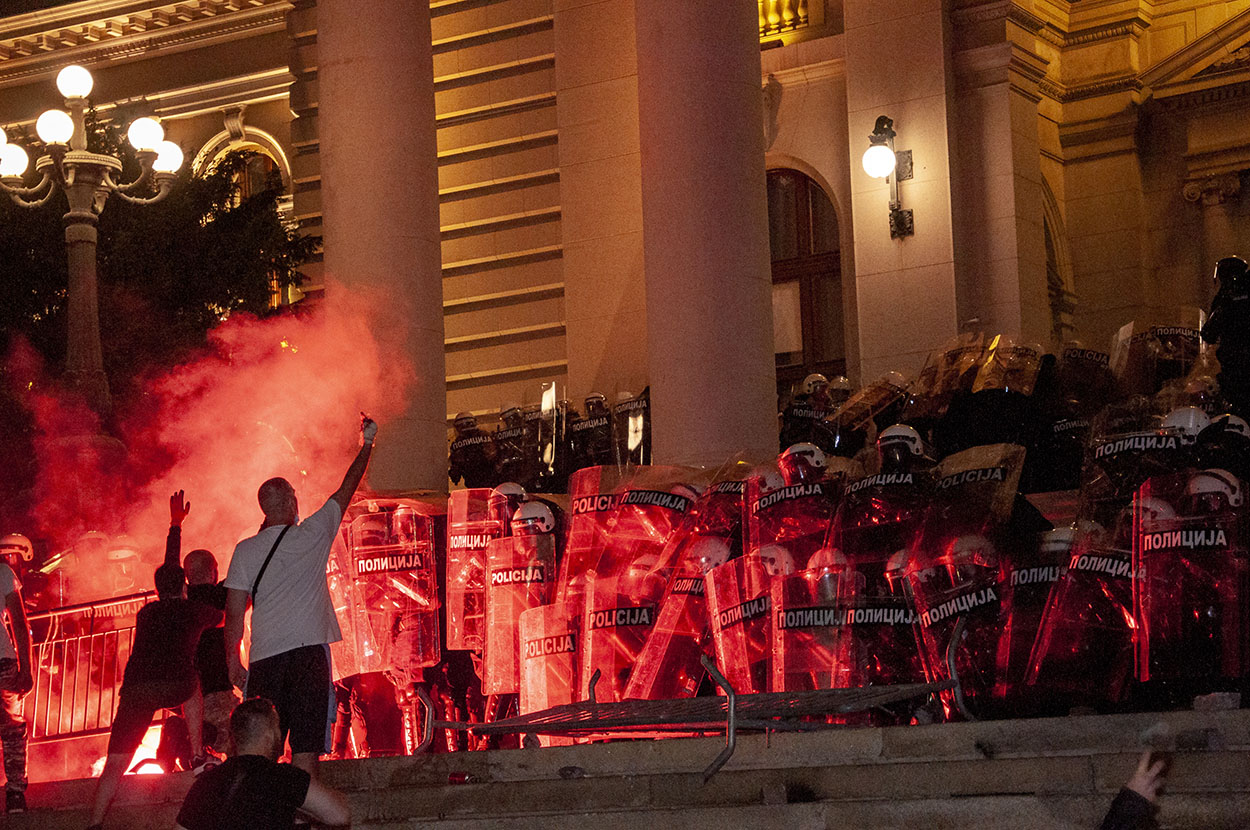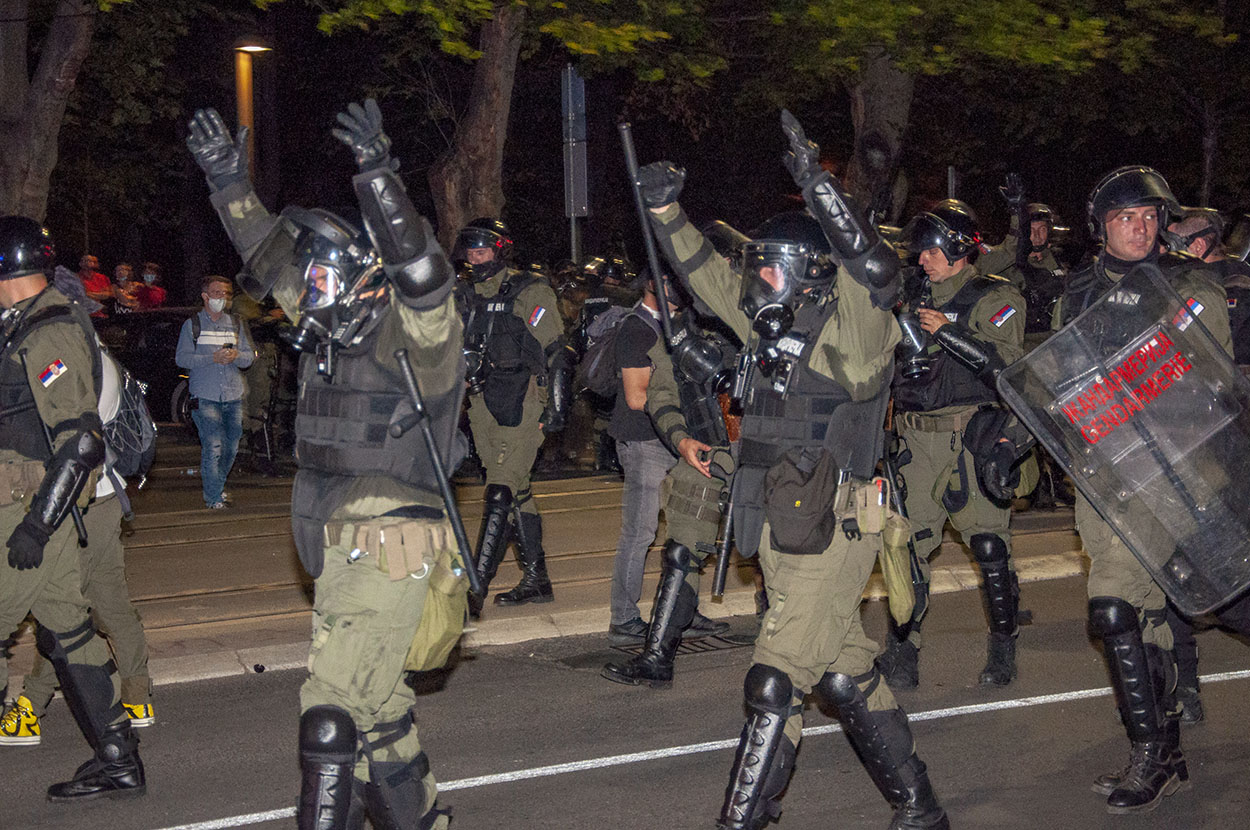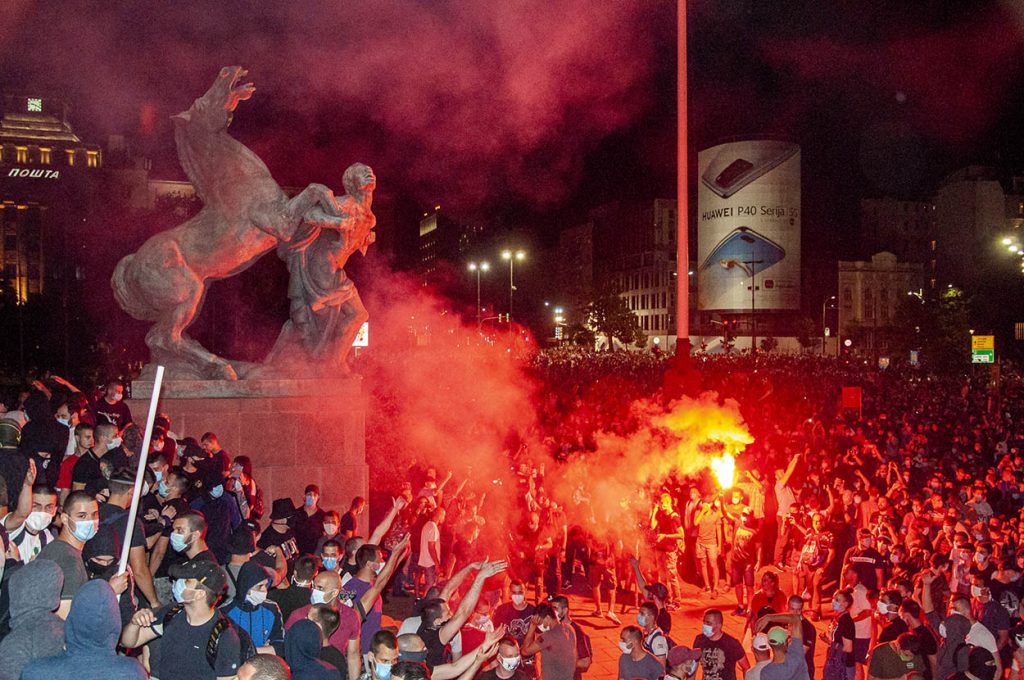Protests in Serbia in the time of coronavirus: Immune to beating and police torture
Citizens in Serbia started protesting after a series of controversy measures that the government had taken from the beginning of the crisis caused by the coronavirus. The announcement on the reintroduction of the curfew in Serbia was the final straw. As it turned out, the mass gatherings were the consequence of the dissatisfaction, not only in expectance of the potential lockdown but also because of the politics of Aleksandar Vucic and Serbian Progressive Party.
Citizens of various political orientations, as well as a different age, went out to the streets, where in a short time we could have witnessed the scenes of police torture and violence over protesters. Highest officials and government representatives were unison in denying police brutality, although numerous videos had witnessed that. Although such scenes of violence in the streets had not been seen since the 90s, as it turned out, hardly any of the representatives of the Ministry of Interior (MI) would be held liable for using the excessive force.

Video footage of arrests and brutal beating had disturbed the public, along with speculations that appeared – the violence had been in fact caused by a group of mercenaries close to the government, in order to “take over” the control of the protests. Non-governmental organisations offered free legal aid to everyone exposed to the excessive use of force by the representatives of the Ministry of Interior. The resignation was demanded from the Police Director Vladimir Rebic. In the meantime, the journalists associations reacted due to multiple assaults on journalists which occurred when they had been reporting from the streets.
The first protest was held on the seventh July, after President Aleksandar Vucic was addressing the nation.
“Starting from tomorrow, in order to prevent spreading of the coronavirus, public gatherings with more than five people in open and closed spaces shall be prohibited, and from Monday to Friday the curfew will be introduced, and afterwards, we will see what happens”, said Vucic.
Just a few hours later, several thousand citizens gathered in front of the House of the National Assembly. The group of men, together with MP Srdjan Nogo, stormed into this institution. The police, in the end, managed to expel them from the Parliament Hall and push them down the main stairs. The civil unrest spilt over towards downtown, and the police threw tear gas on the people gathered there, but also beaten some of the protesters using batons not discriminating whom they were hitting.
On the second evening, the MI reaction was even more brutal. The city was teeming with the equipped police units, and social media were overloaded with numerous videos of citizens being beaten. The protesters’ reaction on the third night was different, as the majority of them were only sitting in front of the Assembly, trying to distance themselves from violent individuals. As the protests continued, the number of people started to drop, but arrests and police beating continued. In the meantime, people started gathering in front of the Central Prison in order to give support to those who had been “unlawfully arrested, beaten and some of them even convicted under the urgent proceedings”, as one of the opposition leaders who had joined the gathering had said.
It has been a while since we witnessed the scenes of violence in the streets of Belgrade, although we had numerous protests in the last years. The ruling party message was that secret intelligence and right-wing groups were “behind everything”, which was a way to justify police brutality. However, among the arrested, the names which caught the most attention of the domestic public, include distinguished activists, scientists and cultural professionals…

Igor Stanojevic, Festival BELDOCS curator, also a member of NUNS, film critic and “Politika” newspapers associate, was arrested regardless of his journalist legitimation, and the police forcefully held him on the street for more than one hour. Dr Vladimir Mentus was arrested between 11th and 12th July, and his colleagues said that he had been beaten in the police station. Miran Pogacar, “Roof over Your Head” activist, was arrested in Novi Sad, and during the rally, he was reading the demands of the protesters.
Police forces, as it turned out, made no difference between violent and non-violent protesters.
After the first round of the unrest, the Police Director Vladimir Rebic estimated that during the protests the police had been “restrained at a maximum level most of the time, trying not to use the force, until in the end, it was inevitable”.
Similar claims could be heard from the majority of the officials – about police professionalism and aggressive protesters. However, these statements were refuted by the citizens and journalists’ cameras recording numerous examples of excessive use of force by the police over the citizens – even when they had demonstrated no resistance, nor came after the police first. In the massively shared footage from the first evening, one could see that people lying on the concrete were beaten, as well as people just sitting on a bench in the park, including the woman who was not confronting at all.
The Police Director said that he had no plans to resign.
The beating was accompanied by the unprecedented amount of tear gas. Prime Minister Ana Brnabic said that the protestors were the ones throwing tear gas on the MI forces. This statement was contested by documented video footage.
“People from the police were very much restrained. They started intervening at the moment when the violence became unbearable, when their life was in danger. Despite everything, the police had regained complete control over the entire space in a very rational and normal way”, said Minister of Interior Nebojsa Stefanovic.
However, not only there were recordings of the punches administered on the citizens lying in the street, but also, in one of the videos, the police officers in Novi Sad had the first attacked the boy on the bicycle, for whom it turned out he had autism. In addition, the police attacked journalists, despite them presenting their press cards.
The Ombudsman made a statement that the police had not used excessive force, except in individual cases due to which the oversight procedure of the MI work legitimacy was instigated. Several civil society organisation approached the European Union institutions, mentioning, among other, that “brutal police violence against the protesters in Belgrade, covered by global press agencies, is disturbingly reminiscent of the 90s in Serbia and has no place in a democratic country aspiring to the EU membership”.
Some of the participants in the protests testified for some national media, that although they were not aggressive and had not participated in the unrest, the police had beaten them.
Ivan Cvetic gave a statement for CINS that he had arrived at the protest somewhat later, around half past nine in the evening. He said that he had not participated in the attacks on the police and that he had been avoiding frontlines.
In his words, the tear gas was used, and people started running trying to save themselves the best they knew how.
“A bunch of them approached me, and as many as could have fit that space, they did, and they hit me. I think that the maximum three of them could have beaten me. One would hit you once or twice, and then the other would come. I believe that at least five of them were taking turns”, said Cvetic to the press.
In the meantime, among the theories circulating the public, the story was that the parapolice forces were participating in the violence over the protesters. Namely, the president of the Party of Freedom and Justice, Dragan Djilas, said that in past days those structures “arrested protesters without the legitimacy”, and that they were also close to the former state secretary of the Ministry of Interior (MI) Dijana Hrkalovic.
Balkan Insight journalists identified key locations where the cases of brutal police interventions and violence had occurred.
It is especially worrying in Serbia, as regards the police brutality, that the police officers are rarely sanctioned in such cases. As reported by Istinomer, if you were searching for online information whether some police officer in Serbia was punished due to the excessive use of force and brutality demonstrated in any of the protests, you will get the impression that the beatings in the streets had never happened here.
The tradition of rare sanctioning of the police officers for excessive use of force in Serbia is also in line with the statement of the current Police Director Vladimir Rebic, who had said that he was “convinced that none of the police officers will ever end up in jail”.
A rare example of the convicted police officers, who afterwards lost their job, were the Gendarmerie officers from Nis. They were found guilty for abuse and torture as on the day of the Pride Parade in 2014 they had beaten Andrej Vucic and Predrag Mali, brothers of Aleksandar Vucic and Sinisa Mali.
There are numerous examples that the persons arrested in the last protests were sentenced in a rush. As reported by the media, some of them were convicted for disturbing public peace and order, some for insulting the police officers, and all these judgments, as reported by Nova S, were ruled by two judges – Djuro Pavlica, the judge of the Misdemeanour Court and Jovo Vukcevic, the judge of the First Basic Court in Belgrade.
Pavlica became known in public after the proceedings related to the assets of Sinisa Mali.

